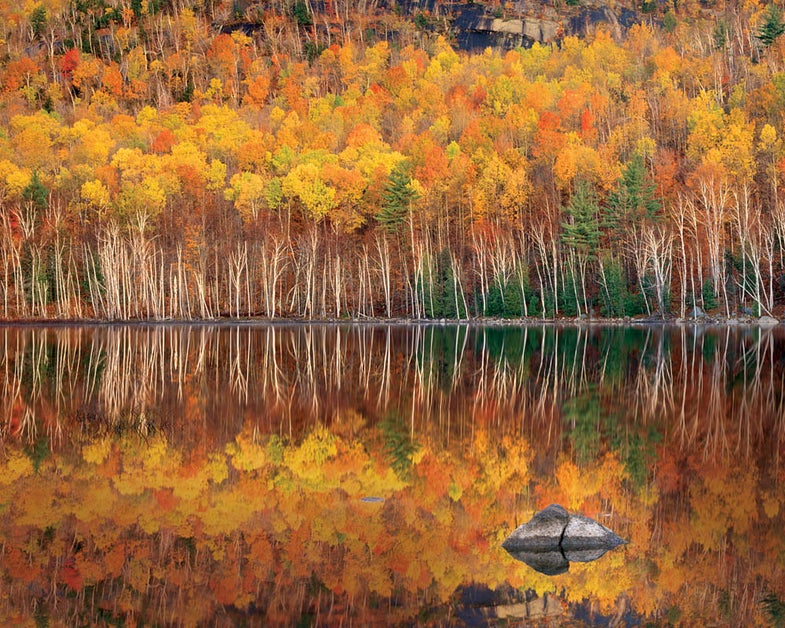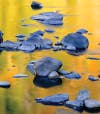5 Tips for Better Fall Foliage Photos
Follow this advice to get the very best shots of the season

Tip 1: Make a Mirror Reflection

Round Pond, Adirondack State Park, New York
Tripod-mounted K.B. Canham DLC45 view camera with 150mm f/5.6 Rodenstock Apo-Sironar- N lens; 2 sec at f/22 on Fujichrome Velvia 50.
Windless conditions are critical for achieving mirror-like reflections of autumn color in water. But an uninterrupted mirror can create too static a picture. Instead, look for rocks or logs in the water to break up the reflection and to provide a visual anchor to help strengthen your composition.
Another key factor: the angle of the light. I made this photo at sunrise, when first light started to strike the peak autumn color. Plan to be on location for sunrise and sunset to capture moody autumn shots—midday sunny weather won’t provide nearly as much drama.
Don’t worry, though, if you don’t have ideal weather every day. Fall often brings cool and moist conditions— a magical recipe for fog, morning dew, and striking sunsets and sunrises. I love it when so-called bad weather moves in, as unstable weather can often result in the most photogenic conditions.
And don’t stop shooting when peak color fades. Sometimes you can make the best fall photography when the trees stand bare and fallen leaves carpet the forest floor. You’ll find poignant images in a mostly bare tree with just a few lone leaves still clinging to the branches.
Post-peak also offers a great time for you to look for scenes of streams and waterfalls with rocks covered with leaves.
If an early snow or frost comes your way, you can also show the transition between autumn and winter.
Tip 2: Capture Color Combinations

Aspens, Acadia National Park, Maine
Handheld Canon EOS 5D Mark II with 17– 40mm f/4L Canon EF lens; 1/160 sec at f/16, ISO 400.
Everyone loves bold autumn color juxtaposed with a brilliant blue sky. Frame the most vibrant sunlit reds and yellows against the sky to create the strongest color scheme; including a few puffy, white clouds can’t hurt, either.
For the photo above, I pointed my wide-angle lens up for this dizzying view of aspen trees. The sun was included for compositional interest, and a small aperture was used to create a sun star.
You can use a polarizing filter to darken skies and increase contrast with clouds. (I did not use a polarizer here, as the camera was at the wrong angle to the sun and, with this wide a lens, the sky would’ve been darkened unevenly.)
Blue sky, though, is not the ideal lighting for other types of scenes. Overcast light often works best for streams and waterfalls, as in the shot below, and a little bit of drizzle can really help to saturate autumn colors. In situations like this, a polarizer, by reducing reflections and cutting through glare, strongly enhances color.
Polarizers also act as neutral-density filters, reducing light without shifting color, which allows me to use a longer shutter speeds.
It’s never been easier to ID the right place and time for peak autumn color. The Weather Channel (www.weather.com/activities/driving/ fallfoliage), Foliage Network (foliage network.com), and other websites let you monitor fall color progression. A number of sites are dedicated to specific areas of the country—do a search for yours. Watch out: Color peaks earlier at higher elevations, and this may not always be reflected in online reports.
Tip 3: Scatter Leaves

Second Falls of Cedar Run, Shenandoah National Park, VA
Tripod-mounted K.B. Canham DLC45 view camera with 90mm f/4.5 Nikon Nikkor SW lens and polarizer; 8 sec at f/32 on Kodak Ektachrome 100VS film.
Autumn is one of my favorite times to shoot because it’s one of the few times I’m not completely at the mercy of the landscape and the light. As I hike along a trail, I like to gather fallen leaves, looking for the most colorful. When I arrive at my shooting location, I strategically scatter them in order to enhance the scene.
This works particularly well for waterfalls and streams (sprinkle rocks with color), and intimate still lifes (add a splash of leaves to a shot of bracken ferns). Just make sure that your scattering looks natural—too many leaves facing color-side up are a dead giveaway that the scene has been arranged.
Tip 4: Isolate Colors and Detail

Ausable River, Adirondack State Park
Tripod-mounted K.B. Canham DLC45 view camera with 450mm f/9 Nikon Nikkor-M lens; 4 sec at f/45 on Kodak Ektachrome 100VS film.
create compelling images by photographing autumn color—but not the trees—reflected in water. In the photo above, the foliage of the trees on the opposite bank was sunlit; the water, was in shadow, so I was able to create color contrast between the warm tones and the rocks lit by cooler light from the blue sky.
For an even more impressionistic effect, photograph reflections in blurred moving water, such as a fast-flowing brook or mountain stream, or rippled lake water on a breezy day. Experiment with exposures of 1/2 sec or longer to capture a pleasing amount of motion blur. Don’t go too long, though, to avoid smoothing out the water and reflections too much. Zoom in with a telephoto lens to exclude all but the most colorful reflections in the water; rapids and boulders can help enhance the scene.
When photographing reflections, a polarizing filter can help to bring out the colors if you dial it up only slightly—a little bit of polarization can enhance the scene, but too much can reduce or eliminate reflections.
While you’re zooming, look for intimate still-life images. A 70–200mm lens (for full frame) is perfect for such scenes. I like to capture the details that help tell the story of the changing of the seasons. Look to zero in on a distant autumn hillside, dew-covered leaves carpeting the forest floor, or just a dash of fall color reflected in a still lake.
Don’t focus all your efforts on trees—plenty of other flora, such as ferns, blueberry bushes, and other ground plants, take on autumn hues. Pattern photos of bracken ferns are an autumn classic; ripening berries are also another cue that fall is in the air.
Tip 5: Create Fall Abstracts

Tree trunks, Adirondack State Park
Handheld Canon EOS 5D with Sigma 50–500mm f/4.5–6.3 DG OS lens and polarizer; 1/2 sec at f/32, ISO 50.
This season is a great time for making impressionistic motion-blurred images. Although wind often creates problems when photographing autumn foliage, you can use it to your advantage. So if it starts to blow too hard for sharp shots, switch gears and go for motion blur.
Look to take fall photography of wind-blown foliage using long exposures of 1/2 sec or more. Such images usually work best if some portion of the scene remains stationary, such as a solid tree trunk surrounded by wind-blown autumn foliage. Use a tripod to ensure that stationary objects are rendered sharp in your photo during the long exposure.
No wind? Try creating your own motion blur by moving the camera during a long exposure to create interesting abstract blurs, as I did in the image above, where I swiped my camera vertically. This technique works well when photographing forest scenes with lots of color. About 1/2 sec to 2 sec of exposure time usually works best with this technique.
Great Places to Shoot
Green Mountains, VT: This pleasant mix of quaint rolling farmland and hillsides covered with brilliant red maples always makes the top of everyone’s fall color list.
White Mountains, NH: Don’t miss the Kancamagus Scenic Byway, which cuts
through some of the most dramatic autumn scenery in the mountains. Adirondack Mountains, NY: The Lake Placid region has stunning mountain scenery, and countless alpine lakes and brooks make for perfect reflection photos.
Acadia National Park, ME: Famous for its rocky coast, this is leaf-peeping paradise, with red blueberry heath atop Cadillac Mountain and maple forests below.
Lake Superior, MN: The north shore has thundering waterfalls and towering cliffs. The fall color under Superior’s stormy weather often yields dramatic images.
West Virginia: Blueberry bushes on the Dolly Sods plateau blaze red in early Oct. Canaan Valley peaks a week or two later. Blackwater Canyon’s mix can’t miss.
Great Smoky Mountains National Park, NC and TN: Some of the finest fall color in the southern U.S., with a dramatic range of elevations for a variety of tree species and peak foliage times.
Blue Ridge Parkway, NC and VA: With 469 miles of mountains, waterfalls, and rolling hills, there’s no end to the photographic possibilities.
Shenandoah National Park, VA: D.C.-area residents are just two hours away from sweeping mountain vistas and bold autumn foliage.
Upper Peninsula, MI: Hot spots include the Porcupine Mountains, Tahquamenon Falls, and south shore of Lake Superior at Pictured Rocks National Lakeshore.